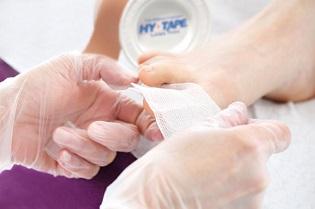Diabetic Foot Ulcers: Topical Management Strategies
August 28, 2019
By Hy-Tape International
According to a published study, the global prevalence of diabetic foot ulcers (DFUs) is 6.3%, with male patients and older adults being the most likely to be affected.1 This prevalence, coupled with the potential for complications and the severe effect on quality of life the condition can have, makes DFUs one of today's most serious health care issues. To reduce the effects of DFUs and improve outcomes for patients, it is critical that health care professionals rapidly identify DFUs and implement best practice dressing and management strategies.
Identifying Diabetic Foot Ulcers
Up to 25% of patients with diabetes will develop foot ulceration in their lifetime. This makes it important that health care professionals regularly check their patients with diabetes for signs of ulceration and identify risk factors. Patients who have had diabetes for an extended duration, those that have had previous ulcerations, those with peripheral arterial disease (PAD), those who have lost sensation in their lower extremities, and older adults are at particular risk. Patients presenting with DFUs generally experience pain, swelling, and odor emanating from the foot. Identifying these signs early on can help prevent complications and keep the wound from worsening.2
Secondary Wound Dressing Application: Tips to Extend Wear Time
Diabetic Foot Ulcer Management Strategies
Effective treatment of DFUs starts with physical examination. Patients suspected of having the condition should be examined for signs of clinical presentation. Patients with peripheral vascular disease should immediately receive compression therapy to reduce their risk of developing DFUs. If an ulcer is found, the treatment focus should be on achieving rapid and complete wound healing. The wound should be regularly debrided to keep it free of non-viable tissue, and clinicians should select dressings that reduce bacterial load and provide an optimal healing environment.3
Effectively Dressing Diabetic Foot Ulcers
Creating an optimal environment is essential to ensuring rapid healing and preventing complications. However, it can be challenging to effectively dress wounds located on the foot, particularly in cases of deformity or disease such as Charcot foot. To dress these wounds appropriately, health care professionals must often use non-traditional methods. Using best practices and more effective medical adhesive products can allow dressings to stay secure longer, even in unusual locations.2,4
Infection Control – Infection in DFUs can lead to inflammation, delayed wound healing, gangrene, and amputation. To reduce the risk of infection and improve outcomes, health care professionals can use dressings that control bacterial load in the wound. Antibacterial agents such metronidazole gel and sisomicin can help control pathogens in the wound area.5
Wound Protection – Because DFUs are located on the foot, they are more susceptible to additional injury than wounds in a less exposed location. This makes it important to choose a dressing that provides some amount of mechanical protection. Dressings that are secure and substantial can protect the wound area from additional damage. Using offloading techniques such as total contact casts and removable cast footwear can also help provide support the foot and prevent repetitive trauma.5
Exudate Management – Although creating a moist healing environment is important to effective wound management, excess exudate can cause maceration and excoriation. It is critical that health care professionals choose a dressing that is appropriate for the wound. For DFUs, this is generally a dressing that is non-adherent and can absorb exudate, such as a foam dressing.4
Conclusion
An effective dressing strategy is one of the best ways of managing a DFU and preventing infection. Hy-Tape's strong, waterproof properties can help to reduce costs when managing a DFU and can also improve healing rates. Health care professionals will appreciate Hy-Tape's seven-day wear time and ability to stay in place even under difficult conditions.
References
1. Pengzi Z, Jing L, Yali J, Sunyinyan T, Dalong Z. Global epidemiology of diabetic foot ulceration: a systematic review and meta-analysis. Ann Med. 2014;49(2):106–16.
2. Diabetic Foot Ulcer. American Orthopaedic Foot and Ankle Society. https://www.aofas.org/PRC/conditions/Documents/Diabetic-foot-ulcer.pdf. Accessed September 2018 .
3. From Complex to Closure: Diabetic Foot Ulcer Assessment and Management. WoundSource. 2018.
4. Stansfield G. Managing wound exudate in the diabetic foot ulcer. Diabetic Foot. 2000;3(3):93–8.
5. Kavitha KV, Tiwari S, Purandare VB, Khedkar S, Bhosale SS, Unnikrishnan AG. Choice of wound care in diabetic foot ulcer: a practical approach. World J Diabetes. 2014;5(4):546–56.
About the Company Hy-Tape International offers high-quality adhesive tape and has served the market for over 70 years. Tapes are available in strips, patches, and kit rolls giving health care providers a wide range of options for securing dressings and devices. Free product samples are available at www.hytape.com or by calling 1-800-248-0201.
Industry Voices is brought to you by health care industry sponsors. All content is developed and paid for by the sponsoring company. Kestrel Health Information, Inc. is not involved in the creation of this content.
The views and opinions expressed in this blog are solely those of the author, and do not represent the views of WoundSource, HMP Global, its affiliates, or subsidiary companies.












Follow WoundSource
Tweets by WoundSource